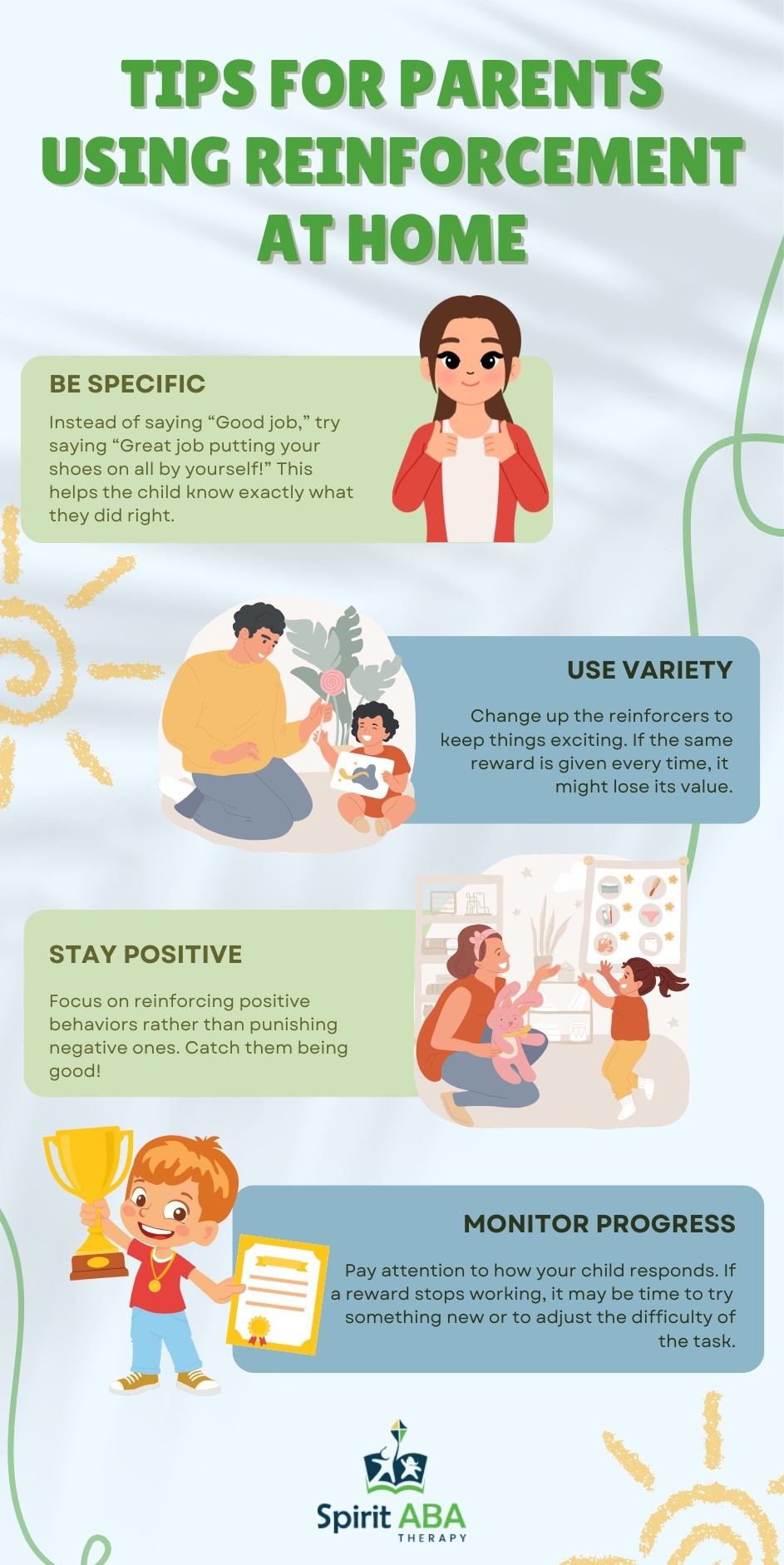Key Points:
- Reinforcement in ABA is a way to encourage positive behaviors by following them with meaningful rewards.
- There are two main types of reinforcement—positive and negative—and both can be applied thoughtfully to help children learn.
- Understanding how reinforcement works can empower parents to support their child’s progress in everyday situations.
Some days feel like a string of small victories—your child shares a toy, tries a new food, or makes it through the morning routine without tears. Other days, those moments feel miles away. Understanding how reinforcement works in ABA therapy can help make those wins more frequent and meaningful.
What is Reinforcement in ABA?
Reinforcement in ABA (Applied Behavior Analysis) is one of the most important tools used to help increase desired behaviors and decrease unwanted ones. In simple terms, reinforcement in ABA means giving a child something they value (or removing something unpleasant) right after they do a desired behavior. This increases the likelihood that they’ll do it again in the future.
Parents often hear about “positive reinforcement” but may not fully understand how it fits into their child’s therapy. Reinforcement in ABA is more than just giving out stickers or candy; it’s a carefully planned strategy that meets each child’s unique needs and motivates them in meaningful ways.
 Why is Reinforcement Important in ABA?
Why is Reinforcement Important in ABA?
Reinforcement is at the heart of how learning happens. Children with autism may not automatically respond to social praise or internal motivation the way neurotypical children do. Reinforcement helps bridge that gap by giving them clear and immediate reasons to repeat helpful behaviors.
Without reinforcement, teaching new skills would be much harder. It gives children clear feedback: “That was the right thing to do, and something good happens when you do it!”
Types of Reinforcement in ABA
There are two main types of reinforcement used in ABA. Both are effective when applied thoughtfully and consistently:
Positive Reinforcement
Positive reinforcement means adding something desirable after a desired behavior. For example:
- Giving a child a high-five and a favorite snack after they say “please.”
- Allowing extra playtime after finishing homework.
- Praising a child warmly when they share with a sibling.
Here, the child does something positive, and something they like is given to them right away.
Negative Reinforcement
This may sound confusing because of the word “negative,” but it doesn’t mean punishing the child. Negative reinforcement is removing something unpleasant after the child does a desired behavior. For example:
- Turning off loud music when the child asks politely.
- Ending a challenging task once the child completes a specific step.
In both cases, the goal is the same: to make the desired behavior happen more often.
How Does Reinforcement Work?
Reinforcement works by creating clear connections between a behavior and its consequence. Here are the essential principles:
Immediacy
Reinforcement needs to happen right after the behavior so the child can connect the two. If the reward comes too late, the child may not understand what they did to earn it.
Consistency
At first, reinforcement should happen every time the desired behavior occurs. Over time, the frequency can gradually be reduced.
Individualization
What works as reinforcement for one child may not work for another. Some kids love praise, others respond better to tangible items or special activities.
Examples of Reinforcers
There’s no one-size-fits-all when it comes to reinforcement. Here are some common types of reinforcers parents and therapists use:
Before choosing reinforcers, it helps to observe what the child seems to enjoy or what situations they try to escape from. These ideas can get you started:
- Tangible items: small toys, stickers, or snacks.
- Activities: extra playtime, swinging on the playground, watching a favorite video.
- Social reinforcement: hugs, claps, enthusiastic praise.
- Sensory reinforcement: access to textures or sounds they enjoy.
It’s okay to experiment and find what truly motivates your child.
Tips for Parents Using Reinforcement at Home
Parents play a huge role in supporting their child’s growth outside therapy sessions. Here are some ways to use reinforcement effectively at home:
 Common Misunderstandings About Reinforcement
Common Misunderstandings About Reinforcement
Many parents have questions or concerns about using reinforcement. Let’s clear up some common misconceptions:
“Doesn’t this mean bribing?”
Not exactly. A bribe is usually offered in the heat of the moment to stop a negative behavior, often before the child has done anything positive. Reinforcement, on the other hand, is planned and given after a desired behavior to increase its frequency.
“Will my child always need rewards?”
No. Over time, reinforcement can become more subtle. As your child learns, external rewards are gradually replaced with natural reinforcement like pride, social approval, or the benefits of the skill itself.
“What if my child stops responding?”
This can happen if the reinforcement isn’t meaningful anymore or if it’s given inconsistently. Refreshing the list of reinforcers and sticking to a plan can help.
Support Your Child’s Growth With Spirit ABA
Raising a child with autism can feel overwhelming at times, but you don’t have to do it alone. Professional help can make all the difference, and Spirit ABA is here to guide you every step of the way.
If you’re looking for compassionate, evidence-based ABA therapy in Iowa, Colorado, and Nebraska, Spirit ABA offers personalized programs designed to help your child thrive. By using thoughtful reinforcement strategies and working closely with your family, we aim to create meaningful progress in your child’s everyday life.
Get in touch with us today to learn how we can support your family’s journey!


